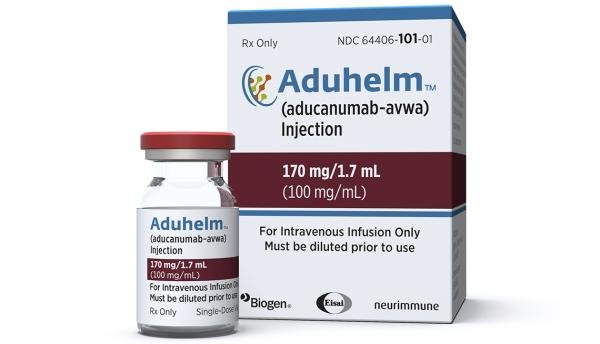Aducanumab Side Effects
Medically reviewed by Drugs.com. Last updated on Dec 17, 2023.
Applies to aducanumab: intravenous solution.
Warning
Intravenous route (Solution)
Warning: Amyloid Related Imaging AbnormalitiesMonoclonal antibodies directed against aggregated forms of beta amyloid, including aducanumab-avwa, can cause amyloid related imaging abnormalities (ARIA), characterized as ARIA with edema (ARIA-E) and ARIA with hemosiderin deposition (ARIA-H). Incidence and timing of ARIA vary among treatments. ARIA usually occurs early in treatment and is usually asymptomatic, although serious and life-threatening events rarely can occur. Serious intracerebral hemorrhages, some of which have been fatal, have been observed in patients treated with class of medications.ApoE e4 Homozygotes: Patients who are apolipoprotein E e4 (ApoE e4) homozygotes (approximately 15% of Alzheimer's disease patients) treated with this class of medications, including aducanumab-avwa, have a higher incidence of ARIA, including symptomatic, serious, and severe radiographic ARIA, compared to heterozygotes and noncarriers. Testing for ApoE e4 status should be performed prior to initiation of treatment to inform the risk of developing ARIA. Prior to testing, prescribers should discuss with patients the risk ARIA across genotypes and the implications of genetic testing results. Prescribers should inform patients that if genotype testing is not performed they can still be treated with aducanumab-avwa; however, it cannot be determined if they are ApoE e4 homozygotes and at higher risk for ARIA.Consider the benefit of aducanumab-avwa for the treatment of Alzheimer's disease and potential risk of serious adverse events associated with ARIA when deciding to initiate treatment with aducanumab-avwa.
Serious side effects of Aducanumab
Along with its needed effects, aducanumab may cause some unwanted effects. Although not all of these side effects may occur, if they do occur they may need medical attention.
Check with your doctor or nurse immediately if any of the following side effects occur while taking aducanumab:
More common
- Blurred or changes in vision
- confusion
- confusion as to time, place, or person
- dizziness
- falls
- hallucinations
- headache
- holding false beliefs that cannot be changed by fact
- mental depression or anxiety
- nausea
- nightmares or unusually vivid dreams
- problems with movement, walking, or speech
- seizures
- sleepiness or unusual drowsiness
- unusual excitement, nervousness, or restlessness
- vomiting
Incidence not known
- Hives, welts, or itching
- large, hive-like swelling on face, eyelids, lips, tongue, throat, hands, legs, feet, or sex organs
- redness of the skin
Other side effects of Aducanumab
Some side effects of aducanumab may occur that usually do not need medical attention. These side effects may go away during treatment as your body adjusts to the medicine. Also, your health care professional may be able to tell you about ways to prevent or reduce some of these side effects.
Check with your health care professional if any of the following side effects continue or are bothersome or if you have any questions about them:
More common
For Healthcare Professionals
Applies to aducanumab: intravenous solution.
General
The most commonly reported adverse reactions have included amyloid related imaging abnormalities, headache, and falls.[Ref]
Nervous system
Very common (10% or more): Amyloid related imaging abnormalities-edema (ARIA-E; 35%); headache (21%); ARIA-hemosiderin deposition microhemorrhage (19%); ARIA-H superficial siderosis (15%), clinical symptoms of ARIA (25%, included: headache, confusion/delirium/altered mental status/disorientation, dizziness/vertigo, visual disturbance, and nausea)
In clinical studies ARIA-E or ARIA-H were observed in 41% of patients treated (454 out of 1105), compared to 10% of patients on placebo (111 out of 1087). ARIA-E was observed in 35% of patients treated at 10 mg/kg, compared to 3% of patients on placebo. The incidence of ARIA-E was higher in apolipoprotein E4 (ApoE4) carriers than in ApoE4 non-carriers (42% and 20%, respectively). The majority of ARIA-E radiographic events occurred early in treatment (within the first 8 doses). Radiographic severity for ARIA-E was mild (30%), moderate (58%), and severe (13%); resolution occurred in 68% of patients by 12 weeks, 91% by 20 weeks, and 98% overall after detection. The manufacturer's product labeling can be consulted for definitions of severity. ARIA-H in the setting of ARIA-E was observed in 21% of patients compared to 1% of patients on placebo. Clinical symptoms were present in 24% of patients with ARIA compared to 5% of patients on placebo and included: headache (13%), confusion/delirium/altered mental status/disorientation(5%), dizziness/vertigo (4%), visual disturbance (2%), and nausea (2%).
Hypersensitivity
Very rare (less than 0.01%): Angioedema, urticaria
Psychiatric
Common (1% to 10%): Confusion/delirium/altered mental status/disorientation
The occurrence of confusion/delirium/altered mental status/disorientation appears to be due to symptomatic ARIA.
Other
Very common (10% or more): Fall (15%)
Gastrointestinal
Common (1% to 10%): Diarrhea
Immunologic
Uncommon (0.1% to 1%): Anti-aducanumab antibodies
More about aducanumab
- Check interactions
- Compare alternatives
- Dosage information
- During pregnancy
- Drug class: miscellaneous central nervous system agents
- Breastfeeding
- En español
Patient resources
Other brands
Professional resources
Other brands
Related treatment guides
References
1. Product Information. Aduhelm (aducanumab). Biogen Idec Inc. 2021.
Further information
Always consult your healthcare provider to ensure the information displayed on this page applies to your personal circumstances.
Some side effects may not be reported. You may report them to the FDA.

